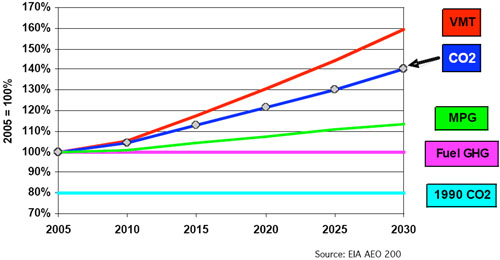Also Blame Where The Buildings Are
The “blame the buildings” series (here, here, and here) was meant to emphasize how energy use in buildings accounts for a bigger chunk of total CO2 emissions than is generally recognized. Of course it also matters where buildings are located relative to other buildings and services, since location has a big impact on transportation-related CO2 emissions.
The Urban Land Institute has just published a report called “Growing Cooler,” that attempts to quantify the effects of land use patterns on transportation-based CO2 emissions. The authors conducted an extensive literature review, which revealed that, as a rule of thumb, compact development reduces driving by 30 percent. And the bottom line: by 2050, if 60 to 90% of new development is compact as opposed to status-quo sprawl, transportation-related CO2 emissions would be reduced from current trends by seven to ten percent.
Seven percent may not sound like much, especially when you factor in that transportation accounts for about 1/3 of total CO2 emissions, so that we’re actually only talking about a two percent total reduction. But, as the authors note, that seven percent reduction must be appreciated in perspective. Assuming business as usual, the U.S. Energy Information Administration currently forecasts that between 2005 and 2030 vehicle miles traveled by cars and light trucks will increase by 59%, with a corresponding increase in CO2 emissions of 41%, as shown in the graph below.

In the context of of motor vehicle fuel efficiency, the authors estimate that if 60 percent of new development is compact, by 2030 the transportation-related CO2 emissions reductions would be equivalent to raising the U.S. fleetwide efficiency to 32 mpg by 2020. Thus, every resident of a compact neighborhood would provide roughly the same environmental benefit as driving a hybrid does today.
The seven percent also does not include CO2 emissions reductions that would result from the higher energy-efficiency of buildings in compact developments (estimated at 20 percent), or from the forests that would be preserved with compact development.
Overall, what all this is saying to me is that there will be no magic bullet solutions. CO2 emissions are so deeply embedded in our way of life that we must go after every potential means for reductions, as aggressively as possible. The authors of the ULI report were probably hoping to be perceived as realistic by choosing 60% compact development as a goal. We need to be shooting for 100%.
